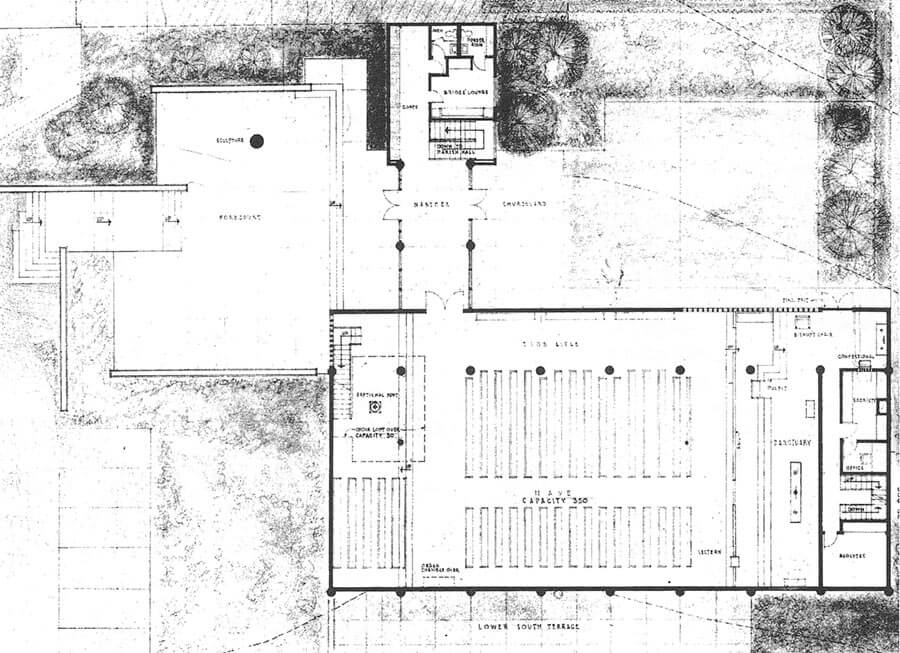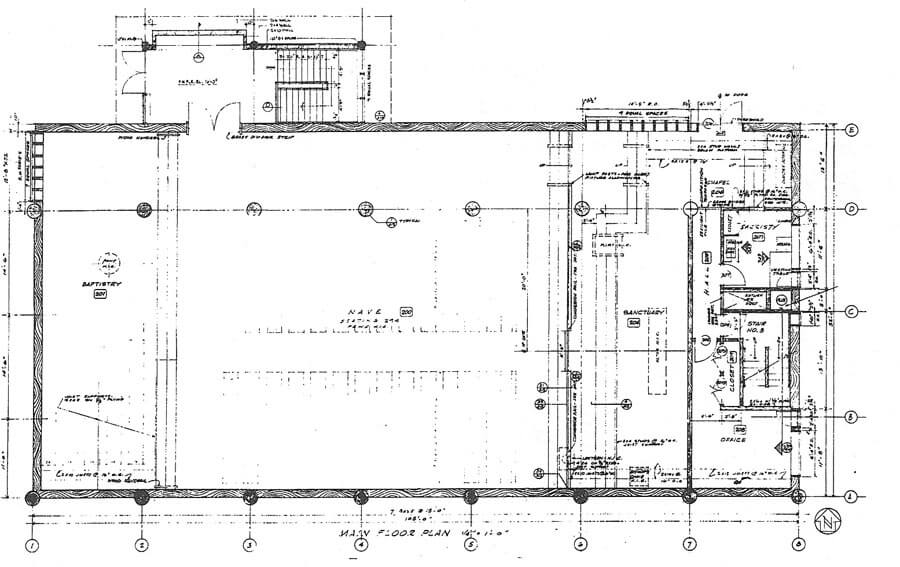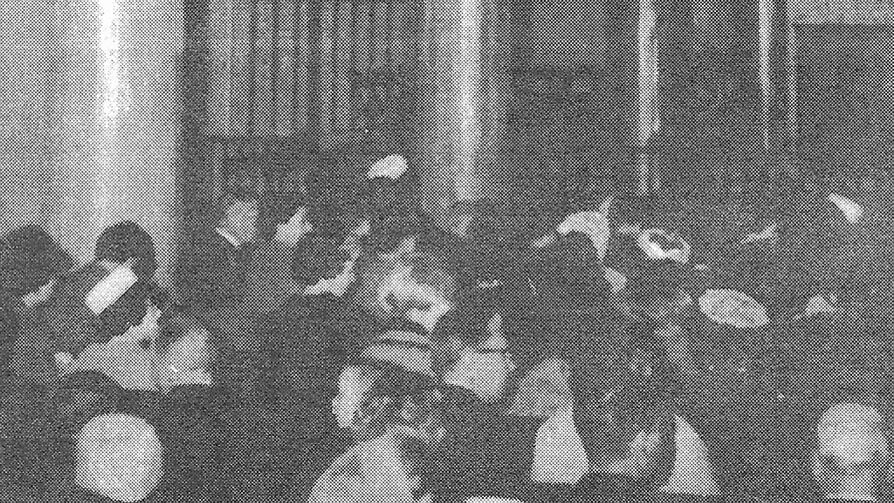
This describes the construction of the current church building by congregants of Church of the Redeemer completed in 1964. The text (with light editing to work better in an online format) and pictures were taken from “A Sense of Place” by Eleanor Pachaud, found in Redeemer: The First Fifty Years.
This is one of several posts celebrating the 75th anniversary of Church of the Redeemer.
Building the current church building
On May 5, 1957, the Reverend C. Roy Coulter became the new vicar at Redeemer. He had previously held the position of curate at Trinity Episcopal in Seattle, and would take the place of the Reverend Richard McGinnis, who would go to Trinity Episcopal to serve in Father Coulter’s former position.
Before coming to Redeemer, Father Coulter spent a summer working for St. Paul’s Episcopal Church in Seattle, and some time doing missionary work in Haiti. He was twenty-six years old upon coming to Redeemer.
Building fund created
On a financial note, during the end of 1955, we held a congregation-wide canvass to start a building fund. This canvass was the last major capital funds drive at Redeemer until the renovation of the pipe organ, over forty years later.
For this canvass, the slogan was “We know that our greatest need is not…’how much our church needs,’ but rather ‘how much we need to give,'” It was a three-year process where the head of each family sat down with a Canvass Leader to discuss how much of a financial sacrifice was to be made, since this sacrifice would strengthen the faith of both the family and the church.

Designing the new building
On June 16, 1960, we received the opportunity to put the fruits of our capital funds drive to their intended use: the architectural firm of Terry and Moore sent Redeemer a letter proposing to set up a contract for the construction of a new building.
The firm included as a partner the noted Seattle architect, Roland Terry, who had been responsible for the architectural planning of several Seattle-area buildings, including the Canlis Restaurant on Queen Anne, and the residence of Seattle Times owner William Blethen.
They also said that they had always wanted to design a church, and this was the perfect opportunity.
A year later, an estimate and a contract had been drawn up. The original cost estimate specified $144,140 for the building development, $10,300 for the property development, and $5,000 for special artwork (like the doves that are currently in the baptistry.) The total estimate was for $159,440.
Less than a month after this figure was drawn up, Father Coulter received a letter from the bishop:
[The diocese is] much concerned with the talk of a building to cost between $150,000 and $200,000 when not more than $25,000, if that, is available in cash and not actually enough to pay the architect. Since Redeemer is a mission, any such outlay of costs must be cleared with [the bishop], the Department of Missions, and both the Bishop’s Committee and the architect ought to understand clearly that no contracts can be signed except with the approval of the Diocesan Council on the recommendation of the Department of Missions.
Obviously, this was no small matter, and it appeared that Redeemer was about to take a plunge into deep debt. The contract was signed anyway.
Later, in an attempt to control the debt, some modifications were made to the original architectural design.
- The height of the building was lowered by five feet, and its length was shortened by fifteen feet, roughly the distance between two columns in the sanctuary.
- The choir loft was taken out (it would have sat about ten feet below where the organ loft is now), as well as the stairway that was supposed to go up to it. This stair would have been where the baptistry is now, and the baptistry would have been under the choir loft.
- The narthex was also redesigned, eliminating an extra set of restrooms and coatroom space.
These changes lowered the cost to about $114,000.
In the spring of 1964, construction began, against the diocese’s wishes. Construction took roughly nine months with the help of hours and hours of volunteer time by the congregation.

Building the new building
Because of its unique design, the construction project faced its own set of challenges. The huge wooden pillars extend from the foundation to the roof and are constructed from single trees. Each pillar was hand-picked and approved at the mill by Roland Terry. Since the pillars had to be put into place first, there was a short period before the structure was sufficiently braced when, in the words of one observer, “if there had been a windstorm, the building would probably have fallen down. “
Once the main building was in place, the next task was to gather all of the furnishings necessary to turn the large, vacant building into a house of worship. Many of these where donated or built on volunteer time.
One especially important volunteer was Robert Thompson. He served as the design coordinator and the building committee chairman. He personally designed the pulpit, altar, lectern, cross, wall sconces, and lighting fixtures.
The altar, altar rail, and lectern were all donated by Bill Martin, a member of the congregation at the time.
The cross from the old building was transferred to the chapel of the new building, and a large, sixteen-foot gold-painted wooden cross was hung above the altar.
All of the pews were donated as memorials, and an anonymous donor donated the large bronze bowl that sits in the baptistry. The bowl was cast in the fifteenth century for Lorenzo de Medici and it bears his portrait and coat of arms.
The planting and landscaping outside the building was provided by Laina and Egon Molbak, founders of Molbak’s Greenhouse and longtime members of the mission.
The final major contribution was made by one family who pledged $16,000 for a full-range twenty-two rank organ to be built two years later. A smaller six-rank organ was donated for temporary use at the dedication.

Dedicating the new building
The dedication of the new building was on Sunday, December 20th, 1964. It was a huge affair described by articles in Eastside newspapers, with no less than five members of the clergy present for the occasion.
- The bishop, The Right Reverend Ivol Curtis, presided over the ceremony
- The Reverend Roy Coulter, vicar of the mission
- The Venerable Paul Langpaap, the rector of Trinity Parish Church and Archdeacon of Seattle
- The Reverend Ernest Radcliffe, curate of St. Paul’s in Seattle
- The Reverend John Thomas, the vicar of St. John’s in Gig Harbor
The junior and senior wardens of Redeemer also participated.
At the end of the dedication, people who walked outside the church noticed a large plume of smoke rising from somewhere towards Lake Washington. It was later revealed that the smoke came from a destructive fire at the Lake Forest Park Clubhouse—the mission’s original home.

Church of the Redeemer
Welcome to Church of the Redeemer: Worshiping God, living in community, and reaching out to the world. We are an Episcopal Church serving north King County and south Snohomish County, Washington. As you travel your road, go with friends walking the way of Jesus at Redeemer.
Church of the Redeemer is at 6210 Northeast 181st Street in Kenmore, Washington. We are a short distance north of Bothell Way, near the Burke-Gilman Trail. The entrance looks like a gravel driveway. The campus is larger on the inside than it is on the outside. And we managed to hide a large building on the side of a hill that is not easily seen from the street.
The Episcopal Church welcomes you.


